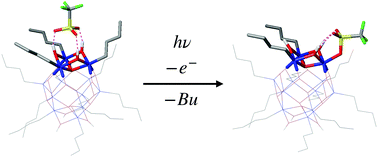UV and VUV-induced fragmentation of tin-oxo cage ions†
Abstract
Photoresist materials are being optimized for the recently introduced Extreme Ultraviolet (EUV) photolithographic technology. Organometallic compounds are potential candidates for replacing the ubiquitous polymer-based chemically amplified resists. Tin (Sn) has a particularly large absorption cross section for EUV light (13.5 nm, 92 eV), which could lead to a lower required EUV dose for achieving the desired solubility change (improved sensitivity). However, the fundamental interaction between organometallic materials and higher energy photons is poorly understood. In this work, we exposed n-butyltin-oxo cage dications (M2+) in the gas phase to photons in the energy range 4–35 eV to explore their fundamental photoreactivity. Photoproducts were detected using mass spectrometry. Homolytic cleavage of tin–carbon bonds was observed for all photon energies above the onset of electronic absorption at ∼5 eV (∼250 nm), leading to photoproducts which have lost one or more of the attached butyl groups (Bu). Above 12 eV (<103 nm), dissociative photoionization occurred for the dication (M2+), competing with the neutral loss channels. The photoionization threshold is lowered by approximately 2 eV when one counterion (triflate, OTf− or tosylate, OTs−) is attached to the tin-oxo cage (MOTf+ and MOTs+). This threshold is expected to be even lower if each tin-oxo cage is attached to two counterions, as is the case in a solid film of tin-oxo cages. Addition of counterions also affected the fragmentation pathways; photoexcitation of (MX)+ (X = counterion, OTf or OTs) always led to formation of (MX-2Bu)+ rather than (MX-Bu)+. MOTs+ was much more reactive than MOTf+ in terms of reaction products per absorbed photon. A possible explanation for this is proposed, which involves the counterion reacting with the initially formed tin-based radical.

- This article is part of the themed collection: 2021 PCCP HOT Articles


 Please wait while we load your content...
Please wait while we load your content...